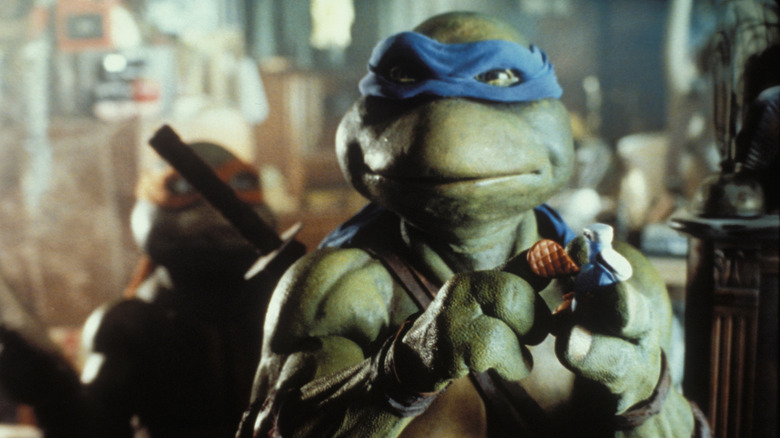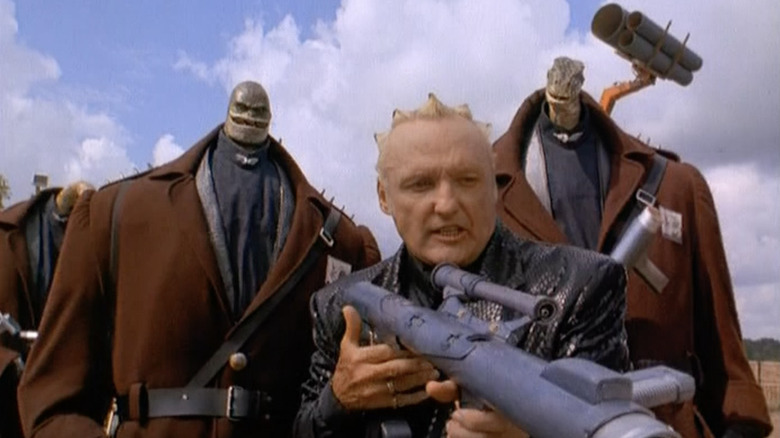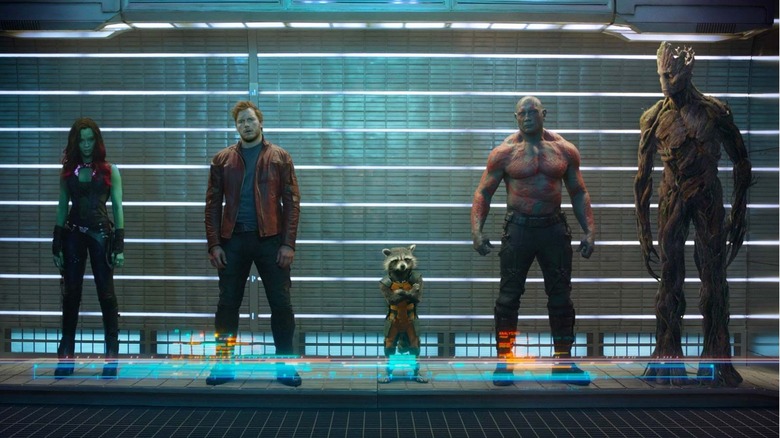How The 1990 Teenage Mutant Ninja Turtles Movie Created The Modern Superhero Comedy
In 1990, music video director Steve Barron cracked the code on combining superheroics and laughs with New Line Cinema's sleeper hit "Teenage Mutant Ninja Turtles," which went on to become (and maintain as its status through the '90s) the highest-grossing independent film of all-time, taking in $200 million worldwide on a $13 million-dollar budget. Based on the comic book by Kevin Eastman and Peter Laird (itself a parody of Frank Miller's "Daredevil" run), the IP had evolved into a popular cartoon show, a toy line, and even an addictive Nintendo video game before it was brought to the screen to enormous success. Even the legendary critic Roger Ebert could barely put a dent in it, admitting it was "probably the best possible 'Teenage Mutant Ninja Turtle' movie.'"
Why was it successful? Because in between jokes about pizza and turtle wax were legitimate moments of violence, struggle, and loss. Barron didn't shoot it with the bright/flat Walmart lighting you often see in kids movies, nor did he stage it with the slapstick silliness of Richard Lester's "Superman" films. The fighting elements are handled with aplomb, no doubt due partially to the film's Chinese production company Golden Harvest, which had helped to popularize martial arts movies in America with "Enter the Dragon" years before. Rather than being hokey, the tragic flashbacks of Splinter's master dying play like outtakes from "Shogun Assassin." The costume designs and animatronics by Jim Henson's Creature Shop (overseen by Henson himself shortly before he died) stayed true to their nature from the comics and cartoon show, walking the line of pop without being too kitsch.
As it happens, tonight (Thursday, October 7) I will be hosting a free NYC outdoor screening event for Alamo Drafthouse where we will be showing "Teenage Mutant Ninja Turtles" 1990-style right above the very sewers where turtles tread in the film. The screening is being put on by Alamo to celebrate the forthcoming fall opening of its new Lower Manhattan theater location, and will begin at 7 P.M. outside of 28 Liberty Street's South Plaza. Expect themed goodies — including some fun TMNT merch and Alamo kids club items — and popcorn before the show! In the meantime, let's take a look back at the movie that cracked the code on making superheroes funny and cool at the same time.
Succeeding Where Others Failed
There are many amazing aspects to the original live-action "Ninja Turtles" — you can see future stars Sam Rockwell and Skeet Ulrich standing next to each other in one shot — but the biggest may be how much it influenced the tone of modern superhero flicks. A lot of it comes down to the film's look, which rather than the colorful palette of the cartoon show carries the same grimdark hyper-stylized big city appearance (possibly inspired by Tim Burton's "Batman) that you would see throughout the '90s in movies like "Jacob's Ladder," "The Crow," "Seven" and "The City of Lost Children." Again, to quote Ebert from his very funny 1990 review, "The city looks like a grungy back-lot version of shabby film noir, and the sewers are like medieval dungeons." A few years later, 1993's "Super Mario Brothers" tried to tap into the same dark visual well and arguably went too far with its cyberpunk grime and repulsive puppetry.
By the time "Ninja Turtles" came to theaters other films had tried and failed to tap into the same kid-friendly comic book tone, namely George Lucas' tone-deaf take on Marvel's "Howard the Duck" and Cannon Films' hopelessly schlocky "Masters of the Universe." The biggest sin both of those efforts committed was deviating too much from the source material, something "Ninja Turtles" took to heart by maintaining the look and feel of the characters and their NYC setting. Casey Jones looked like Casey Jones with his trademark hockey mask. Splinter looked like Splinter. Their subway lair looked like a real sewer, not something sanitized for children. This fidelity to the material proved to be much harder than Barron made it look. Even the follow-ups in New Line's original "Ninja Turtles" trilogy went too far over to camp with 1991's "Teenage Mutant Ninja Turtles II: The Secret of the Ooze" and its embarrassing Vanilla Ice cameo, or the 1993 trilogy capper "Teenage Mutant Ninja Turtles III" and its absurd/lazy time travel conceit.
The Template is Followed
Now that we're deep into the Marvel age of movies, it's easy to see where Kevin Feige and company have taken from the same page of balancing fidelity to the material with just enough levity to point out the natural absurdities of enhanced people in tights fighting crime. Yuck-yuck maestro Seth Rogen, who tried and failed with his own superhero comedy "The Green Hornet," told GamesRadar last year that when he makes comedies now he keeps in mind what his real competition is ... big budget superhero flicks:
"Marvel movies are comedies. 'Thor: Ragnarok' is a comedy. 'Ant-Man' is a comedy at its core. So that's what's out there. There are $200 million comedies out there, and so that's something, as a comedic filmmaker, to be aware of. That is the benchmark that people expect! If you're going to make a big huge comedy, just know that your competition is like Marvel. Not to say you should not make those types of films, but know that's what audiences are seeing, and that, when you see those movies in theaters, they are playing like comedies. They are legitimately funny and star comedy stars. That's something we talk about a lot – just to be aware of as filmmakers. These huge budget films function like comedies. Audiences still love comedy, and they want that — 'Deadpool' — but the scope of them is huge."
While not all of Marvel's output can be classified as outright comedy, there are many that can be: "Guardians of the Galaxy" (and its sequel), "Ant-Man" (and its sequel), "Spider-Man: Homecoming" (and its sequel), "Deadpool" (and its sequel), "Thor: Ragnarok" and even the recent martial arts-themed "Shang-Chi and the Legend of the Ten Rings" leaned strongly into humor. Fox's R-rated "Deadpool" movies in particular are terrific at juggling fourth-wall-breaking absurdity with the elasticity to bounce back into true drama.
On the DC side you can also see the "Turtles" influence in films like the kid-friendly "Shazam!" or the not-so-kid-friendly "The Suicide Squad," whose ridiculous King Shark winds up becoming a surprisingly emotional character who could have fit right into the original "Turtles." Even Sega's recent "Sonic the Hedgehog" took its core drama and mythology of the character seriously even while being goofy enough for a three-year-old to enjoy. With Rogen himself now in charge of spearheading yet another reboot of "Teenage Mutant Ninja Turtles" it's hard to tell if the same lightning in a bottle can ever be captured again, but the influence of the original is hard to beat.


